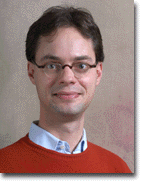| Laboratory of Cellular and Molecular Biology |
Intramural Program Investigators ^ Home ^ |
| Sebastian D. Fugmann, Ph.D., Investigator Head, Molecular Immunology Unit |
 Dr. Fugmann received his Ph.D. in human biology from the University of Ulm, Germany, in 1998. He went on to do his postdoctoral training at Yale University in the laboratory of Dr. David. G. Schatz, and joined the National Institute on Aging, Laboratory of Cellular and Molecular Biology, as a tenure-track investigator in September of 2004. Dr. Fugmann received his Ph.D. in human biology from the University of Ulm, Germany, in 1998. He went on to do his postdoctoral training at Yale University in the laboratory of Dr. David. G. Schatz, and joined the National Institute on Aging, Laboratory of Cellular and Molecular Biology, as a tenure-track investigator in September of 2004.Mechanism of Genome Rearrangements in Lymphocyte Development: B- and T-lymphocytes are unique components of the adaptive immune system in higher vertebrates. They stand out by their abilities to recognize an enormous variety of pathogens and to initiate a highly specific response to fight the infection. In order to do so, each individual lymphocyte displays a unique antigen receptor molecule (named immunoglobulin, Ig, in B-cells, and T-cell receptor, TCR, in T-cells) on its surface. There are four processes that generate such a remarkable diversity within the genes encoding these antigen recognition proteins: V(D)J recombination, somatic hypermutation (SHM), class switch recombination (CSR) and immunoglobulin gene conversion. They share a common theme in that they involve an active modification of the antigen receptor gene loci in each developing lymphocyte. Thus they also impose a high risk to each cell (and the entire organism) as an error in any of these processes can result in chromosomal aberrations that could ultimately lead to cancer. |
| V(D)J Recombination: The initial Ig and TCR repertoire is generated by V(D)J recombination. In this tightly regulated cut-and-paste process, functional antigen receptor genes get assembled from individual V, D and J gene segments. The only lymphocyte specific factors are encoded by the recombination activating genes RAG1/2. Together with the ubiquitous DNA-bending protein HMG1/2, they form the recombinase complex that cleaves the DNA in the first phase of the process. In the second phase, joining, this complex acts together with many NHEJ family members (Ku70, Ku80, DNA-PKcs, artemis, xrcc4, DNA ligase IV) to religate the broken chromosome. |
| One focus of our lab is to gain a detailed understanding of the mechanism and regulation of V(D)J recombination starting from the initial recombinase complex formation, its interactions with its cognate DNA substrate to the final resealing of the broken DNA. To address these questions, we are performing cell-based assays and biochemical experiments using purified (recombinant) proteins. |
| Evolution of Adaptive Immunity: We recently identified a gene pair in the genome of the purple sea urchin (Strongylocentrotus purpuratus) with striking similarity to the vertebrate RAG1/2 genes. The function of the encoded sea urchin Rag1/2-like proteins (spRag1L/spRag2L) is unknown, as this organism, to our current knowledge, shows no evidence of rearranging antigen receptor genes. We are currently pursuing in vitro and in vivo studies to characterize their molecular function, their role in sea urchin development and immunity, and the relationship to the classical vertebrate RAG1/2 proteins. |
| Immunoglobulin Gene Conversion: This Ig diversification process has been identified thus far in chickens, rabbits and sheep (but not in humans or mice). Sequence information from upstream pseudogenes is copied into the exon of the assembled Ig gene encoding the antigen binding domain to diversify the antibody repertoire. While the precise mechanism of this process is yet unknown, several proteins have been shown to play a critical role. The activation induced cytidine deaminase AID, an enzyme converting C to U within nucleic acids, is thought to create an initial DNA lesion within the respective Ig gene, and several DNA repair factors involved in homologous recombination act subsequently to patch the lesion using upstream pseudogenes as templates. |
| We chose the DT40 cell line as a model system to identify and characterize novel proteins complexes that are critical for Ig gene conversion. In addition, we designed strategies to identify and characterize regulatory components (cis-acting DNA elements and trans-acting factors) that restrict and limit gene conversion to B-cells of a defined developmental stage and within those specifically to the Ig gene loci. |
| Contact Information: Laboratory of Cellular and Molecular Biology Biomedical Research Center, room 06C218 251 Bayview Boulevard, Suite 100 Baltimore, MD 21224-6825 Phone 410-558-8379 Fax 410-558-8386 E mail fugmanns@grc.nia.nih.gov For more information about the Laboratory: http://www.grc.nia.nih.gov/branches/lbc/lbc.htm |
| IRP Home What's New Contact Us Accessibility Disclaimer Privacy Site Search Site Map NIA Home |
 |
 |
 |